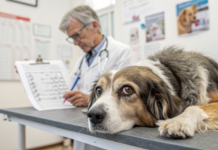Last Updated on April 9, 2022 by Dogs Vets
Top 9 Best Pets and Dog Thermometers According to Veterinarians
Thermometers are used to measure the body temperature of animals. Veterinarians often use thermometers to determine if an animal is healthy or not.
Now Let’s dive in..
The best dog thermometer should be able to give accurate readings, be user-friendly, have long battery life and be easy to clean. Here are the top 10 best dog thermometers according to veterinarians:
Cats and dogs are susceptible to a variety of temperature-related issues
. You should regularly monitor your pet’s temperature, but it can be difficult to take their temperature with a traditional thermometer because cats and dogs have thick fur coats that make it hard to read.
A dog’s body temperature is typically higher than a human’s. So when a pet owner is worried about their dog, they should take the temperature of their pet to see if they have a fever.
The best way to take the temperature of a dog is by using a thermometer designed for dogs.
There are many different types of thermometers on the market and it can be difficult to know which one to buy. This is why we have compiled this list of the top 10 best dog thermometers according to veterinarians, so you don’t have to worry about it anymore.
#1. PetMedics Pet Thermometer for Dogs

The iHome PetMedics Non-Contact Digital Thermometer is a handy tool for pet owners. It’s an infrared fast and accurate thermometer for dogs that can be used on your pet’s forehead or rectal area.
This product is perfect for anyone who wants to take their pet’s temperature without having to touch them with a thermometer. It’s also great for people who are afraid of getting bitten by their pet when trying to take their temperature.
#2. Hzran Pet Veterinary Thermometer

The Hzran Pet Veterinary Thermometer, Pet Accurate Fever Detection Thermometer, Animal Temperature Monitor, and Fast Read Digital Vet is an accurate and easy to use thermometers for pets.
It has a long-distance infrared sensor that can detect the temperature of an animal up to 6 feet away. This thermometer can also be used for human beings and has a fever detection system that will alert if the temperature reaches 39 degrees Celsius.
#3) ADC Veterinary Dog Thermometer

The ADC Veterinary Thermometer, Dual Scale, Adtemp 422 is an essential tool for veterinarians. It is a thermometer that has a dual scale and the temperature can be read in Fahrenheit or Celsius.
The thermometer is designed to be used on all animal species and it has a range of 32°F-122°F or 0°C-50°C.
The ADC Veterinary Thermometer, Dual Scale, Adtemp 422 can be used on any animal species and it has a range of 32°F-122°F or 0°C-50°C. The unit of measurement can also be changed to Celsius or Fahrenheit.
#4) AURYNNS Pet Thermometer for Dogs and other Pets

AURYNNS is a company that specializes in pet care and it has been in the business for over 10-years. It offers a wide range of pet products like pet thermometers, water bowls, mats, and more.
This product is a digital thermometer for pets with a long probe that can be used to measure the temperature of different types of animals. It is FDA approved and it can be used to measure the temperature of dogs, cats, horses, cattle and poultry.
The AURYNNS Pet Thermometer is easy to use – all you have to do is point the device at your pet’s mouth or anus and wait for 3 seconds to get an accurate reading.
#5. Hzran Pets and Animal Veterinary Thermometer

The Hzran pet veterinary thermometer is a fast and accurate way to measure the temperature of your animal. It is a digital vet that can be taken by your pet and then scanned by the owner to get the temperature reading.
It has a large screen that displays the temperature in Fahrenheit or Celsius, and it also has an auto-off feature for safety. Can be used for Dog, Cat, Rabbit, Horse, Pig, Hamster, Guinea Pig.
#6. The MINDPET-MED Fast Clinical Pet Thermometer for Dogs and other animals

The MINDPET-MED Fast Clinical Pet Thermometer is a device that can be used to measure the body temperature of animals.
It has three different modes in which it can measure the temperature. The first mode is to measure the surface temperature of an object, the second mode is to measure the room’s surface temperature, and the third mode is to measure an animal’s body temperature.
The MINDPET-MED Fast Clinical Pet Thermometer has a quick response time, which makes it easy for veterinarians and pet owners alike to use.
It also has a large LCD screen that displays your pet’s current body temperature as well as its high and low alarm values. This thermometer will also remember your last measurement so you don’t have to keep re-entering information every time you use it.
#7. DWSFADA Digital Waterproof Thermometer for Pets and regular Animals

This is a pet thermometer that is waterproof, easy to use and has an ultra-fast reading. The DWSFADA Waterproof Digital Thermometer for Pets, Animal Electronic Thermometer Care Tool Fast Reading Pet Thermometer 32-43 Degrees Fahrenheit is designed to be used on all types of animals. It can be used to measure the temperature of the animal’s mouth, rectum or ear.
The thermometer has a large LCD screen that can be read from any angle. It also has an alarm function that will alert you when the temperature reaches a certain point. This way you can take measures to keep your pet safe as soon as possible if they are running a fever or have another medical condition.
#8. BV Medical AnimaTemps Dogs Thermometer

The BV Medical Animatemps Dog Digital Thermometer is a thermometer that is used to measure the temperature of animals.
The Animatemps Dog Digital Thermometer uses infrared technology to measure the temperature of an animal in just seconds.
It also has a fever alarm which alerts the user when an animal’s temperature exceeds 104 degrees Fahrenheit.
This device can be used on dogs, cats, horses, or any other type of animal.
This device has been clinically tested and approved by the FDA.
#9. The Fast 10 Seconds Body Fever Thermometer for Pets, Adults, Children, Kids, Infants, Babies

The Fast 10 Seconds Body Fever Thermometer is the world’s first, fastest, and most accurate fever thermometer. It is a must-have for any household with children, babies, pets or adults.
This thermometer is the best choice for people who are always on the go. It can measure body temperature in under 10 seconds and be used in all three ways: oral, rectal and underarm.
#10. The MEETI Cat and Dog Ear Temperature Monitor for Pet Only

MEETI Cat and Dog Ear Temperature Monitor is a pet only thermometer that can measure your pets temperature by touching their ear. It is FDA approved for use on cats and dogs, and has a warranty.
The MEETI Cat and Dog Ear Temperature Monitor uses infrared technology to quickly and accurately measure the temperature of your pet’s ear.
The FDA approved sensor will not hurt your pet while measuring the temperature, which makes it safe to use on all breeds of cats and dogs.
With the MEETI Cat and Dog Thermometer, you no longer have to worry about giving your dog or cat medicine when they are sick because you can check their fever before you administer any kind of treatment.
It’s also waterproof so you can take it in the shower
Facts Check
We hope you enjoyed this article… What are your thoughts on Best Dog Thermometers?
Рleаse feel free to share with us in the comments section below!

















